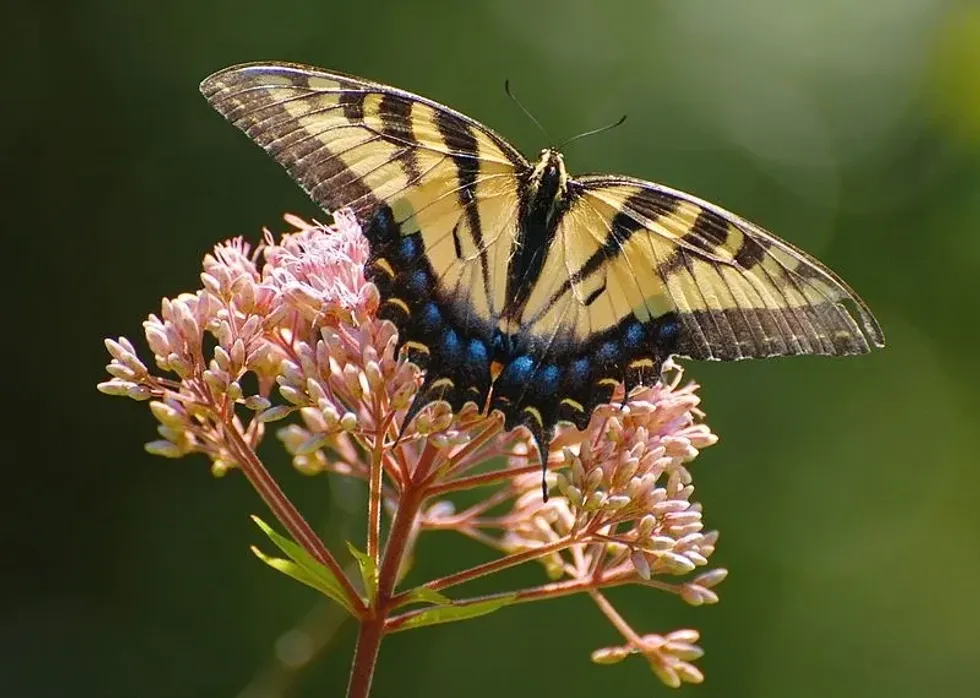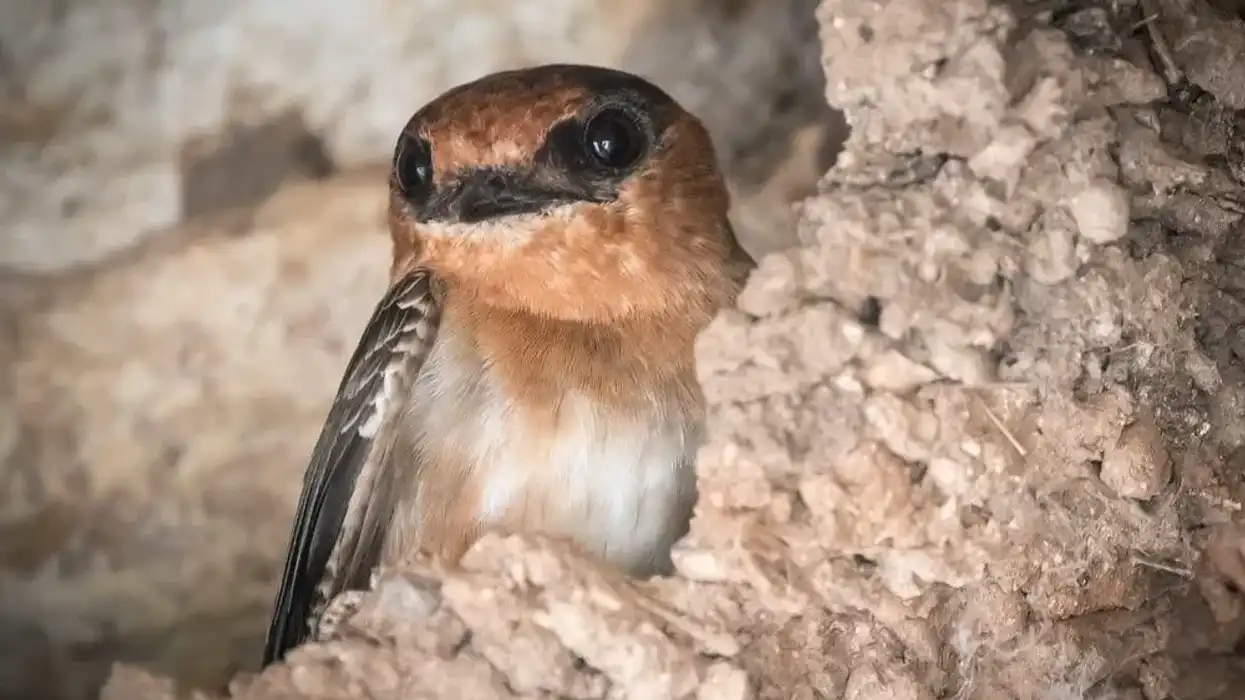An eastern tiger swallowtail is a beautiful butterfly that is native to North America and primarily inhabits the south of Ontario to northern Mexico and the Gulf Coast. These are vibrant butterflies that belong to the class of Insecta.
An eastern tiger swallowtail's color may vary and is not necessarily the same. Males have black stripes and are of yellowish-orange color.
Simultaneously, a female eastern tiger swallowtail's color can vary from a bluish-black solid color to a yellowish-orange of a male.
This species of butterflies are very beautiful and they are eye-catching when they seek out minerals and moisture from the mud, and this process is called 'mud pudding'. An adult eastern tiger swallowtail eats leaves and mostly nectar from its host plant, whereas a larva feeds on the leaves of some woody plants.
They are called eastern tiger swallowtails because of their black stripes that resemble the stripes of a tiger. They are also known to have mastered the art of disguise.
To learn more about these fascinating animals, we have gathered a set of interesting facts about them for you to read. You can also read other articles on the monarch butterfly and painted lady butterfly.
Eastern Tiger Swallowtail Interesting Facts
What type of animal is an eastern tiger swallowtail?
An eastern tiger swallowtail is a type of butterfly that belongs to the family of Papilionidae.
What class of animal does an eastern tiger swallowtail belong to?
Eastern tiger swallowtails belong to the class of Insecta.
How many eastern tiger swallowtails are there in the world?
There is no authentic data on how many eastern tiger swallowtails there are in the world at this moment. However, they are quite widespread.
Where does an eastern tiger swallowtail live?
Eastern tiger swallowtails are native to North America and are located south of Ontario to northern Mexico and the Gulf Coast. They fly from spring to autumn. These butterflies are commonly found in New Hampshire. They live in tropical and warm climates in woodlands and river valleys.
What is an eastern tiger swallowtail's habitat?
An eastern tiger swallowtail habitat mainly comprises of tropical and warm climates. They are found in deciduous broadleaf woods, river valleys, suburbs, gardens, and brooks. They are widespread and are can be found on all continents except Antarctica.
Who do eastern tiger swallowtails live with?
Generally, eastern tiger swallowtails are solitary animals and they prefer living alone. Yet, at times, they are found mud-pudding in groups to absorb and soak in moisture.
How long does an eastern tiger swallowtail live?
Eastern tiger swallowtails generally have a short life expectancy of around 10 to 12 weeks long. They are only adult butterflies for six to 14 days. The longest stages of their life cycle are the caterpillar and chrysalis stages.
How do they reproduce?
An eastern tiger swallowtail life cycle consists of four stages which are the egg stage, the caterpillar stage (larvae), the chrysalis stage (pupal), and the adult butterfly stage. Males wander from place to place in search of a mate.
Females lay their single green eggs on the leaves of their host plant. Eastern tiger swallowtail host plants include wild black cherry, ash, birches, cottonwood, tulip poplar or tulip tree, sweet bay magnolia, and willow.
A tiger swallowtail (Papilio glaucus) is oviparous, which means that it lays its eggs directly and there is no embryonic development within the females' body. Female eastern tiger swallowtails lay their eggs near to the nectar sources on the host plants.
Generally, their eggs are green in color and circular in shape. These eggs turn yellow-green with red spots. It takes a week or two for the eggs to hatch.
Males find the receptive and flexible females on or around the eastern tiger swallowtail host plant. During this period of courtship, males and females fly over and around each other before landing and breeding.
Males discharge pheromones that are perfume-like substances to lure and attract females for mating. Female butterflies produce two to three broods between spring and fall.
When an eastern tiger swallowtail caterpillar is young, it turns brown and white and transforms as it matures. When a caterpillar matures, they are green in color, and they have orange-black fanciful eyespots which are fake.
These eyespots protect them from any threats from predators. The eyespot of caterpillars is an ambiguous coloration that creates an illusion or a misconception for predators. They perceive that the caterpillars are way too big for them to prey on.
Tiger swallowtail (Papilio glaucus) generally attains maturity in the springtime. Many breedings take place every year to produce more specimens of eastern tiger swallowtail butterflies.
What is their conservation status?
Eastern tiger swallowtails, Papilio glaucus, are not listed in the IUCN, International Union for Conservation of Nature. However, they are referred to as Secure, according to the NatureServe conservation status system.
Eastern Tiger Swallowtail Fun Facts
What do eastern tiger swallowtails look like?
An eastern tiger swallowtail's color may vary and is not necessarily the same. Males have black stripes and are of yellowish-orange color.
Their wings are black and lined with yellow spots and they have black stripes similar to tiger stripes that run across the edge of their wings. Males have long black colored tails that have speckles of yellow and blue on them.
A female eastern tiger swallowtail's color may vary from a bluish-black solid color to the yellowish-orange of a male. This yellow female butterfly attracts males, but yellow eastern tiger swallowtail females are more prone to threats posed by predators. In contrast, black butterflies are comparatively less attractive to predators, making them less prone to life threats.

How cute are they?
This species of butterfly is very adorable, especially while they seek out minerals and moisture from the mud, called mud pudding. Moreover, they do not pose any threat to vegetation which makes them more attractive.
People usually plant host plants such as tulip trees, sweetbay magnolia, willow, birches, and carrots to enjoy the beautiful sight of their wings and body.
How do they communicate?
They communicate mainly through two channels, namely, chemical and physical. Eastern tiger swallowtails use chemical channels by releasing perfume-smelling pheromones to entice and attract females to mate. They use physical movements such as flying over and about each other before mating, indicating their consent and interest before courtship.
How big is an eastern tiger swallowtail?
An eastern tiger swallowtail is relatively larger and has a wingspan of around 3-5.5 in (8-14 cm) while basking in the sun. They are comparatively a large species from the class of Insecta and are around 5 in (13 cm) in size. These butterflies are around two times bigger than monarch butterflies.
How fast can an eastern tiger swallowtail fly?
As these butterflies are large, they can fly and move very fast with their wings flapping in slow motions. Although, there is no such estimated value of their speed of flight.
How much does an eastern tiger swallowtail weigh?
As they are very light in weight, they have not been weighed or calculated. There is no information on their weight available for these butterflies, although they are large in size and length.
What are their male and female names of the species?
As per the norm, there are no distinct names given to these butterflies in terms of gender. Both males and females are called eastern tiger swallowtail butterflies.
What would you call a baby Eastern tiger swallowtail?
A baby eastern tiger swallowtail does not have a specific name. They are simply referred to as eastern tiger swallowtail larvae or eastern tiger swallowtail chrysalis (caterpillars), depending on what stage in their life cycle they are at.
What do they eat?
An adult eastern tiger swallowtail eats leaves and mostly nectar of its host plant, including tulip trees, sweetbay magnolias, willows, and birches. Larvae (caterpillars) feed on the leaves of these woody plants as they are polyphagous. This means they eat several woody plants such as cherry, apple, mountain ash, willow, maple, poplars, and occasionally sassafras.
Are they dangerous?
No, eastern tiger swallowtails are not dangerous, neither for plants nor for humans. Although they are not poisonous, they can pose serious issues if consumed by a human.
Would they make a good pet?
No, there is no such information on their captivity or keeping them as pets. These butterflies are wild species, and so they do not make good pets. Instead, you can attract them to your garden for you to enjoy their appearance.
Did you know...
Carrots (or Apiaceae) and black eastern tiger swallowtail butterflies have a unique relationship between them. Carrots provide egg locations for butterflies and food for the larvae. These beautiful vibrant butterflies may get attracted to carrots in your backyard.
An eastern tiger swallowtail can even fly and navigate after losing its wings. After their wings are broken, they manage to fly and navigate with the help of the remaining substantial parts.
How long does it take for a tiger swallowtail caterpillar to turn into a butterfly?
An eastern tiger swallowtail caterpillar usually takes a month to grow completely from a caterpillar to an adult independent butterfly.
How do eastern tiger swallowtails protect themselves from predators?
A black eastern tiger swallowtail is an instance of deceptive or dimorphic coloration that uses mimicry of a poisonous butterfly called the pipevine swallowtail. Caterpillars' eyespots protect them from any threats from predators.
Therefore, this solid black color repels any predators' threats. The eyespot of a caterpillar is an ambiguous coloration that creates an illusion or a misconception. Due to this, predators perceive that the caterpillar is way too big for them to prey on.
Here at Kidadl, we have carefully created lots of interesting family-friendly animal facts for everyone to discover! Learn more about some other arthropods, including pipevine swallowtails or viceroy butterflies.
You can even occupy yourself at home by drawing one on our eastern tiger swallowtail butterfly coloring pages.










